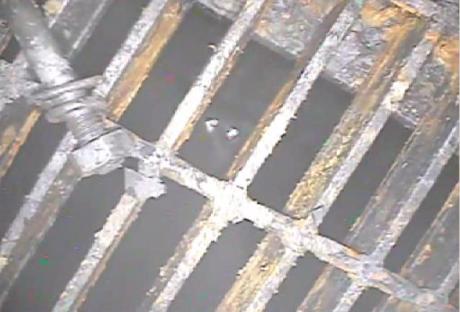Unit 1 containment vessel investigated
11 October 2012
An investigation is underway into the internal conditions of the primary containment vessel (PCV) of the reactor at unit 1 at the damaged Fukushima Daiichi nuclear power plant. Tokyo Electric Power Company (Tepco) said that the water level in the vessel has been found to be higher than previously estimated.
 |
| A still from a video shows a loose bolt resting on the grated walkway above the accumulated water in the PCV of Fukushima Daiichi unit 1 (Image: Tepco) |
On 26 September, Tepco engineers used a machine to punch a 13cm-diameter hole through the thick reinforced concrete primary containment drywell of unit 1. The hole - made at a height of some 8.6 metres above the bottom of the PCV - enables cameras and probes to be inserted for assessing the condition within the vessel.
The company had previously practised the same procedure on the undamaged unit 5, where an endoscopic camera on a flexible cable had brought back fairly clear images and video of the grid-like steel structures and piping that surround the reactor vessel. It was also used at the damaged unit 2 in January 2012, but most of the images appeared largely unhelpful, with some very highly speckled due to radiation.
On 9 October, eight Tepco employees and 45 contractors inserted a video camera, with a diameter of about 7.5cm, into the hole made in the PCV. These gave the company its first insight into the PCV since the March 2011 accident. Tepco spokesman Masayuki Ono said that the video images confirmed that the water surface was in the lower part of the PCV. He added, "It seems we have not yet been able to see damage to large pieces of equipment."
The following day, a charge-coupled device (CCD) camera and a dosimeter were inserted through the hole to measure the accumulated water level and the atmospheric dose within the PCV. The depth of the water within the vessel had previously been estimated at 2.0 metres from the bottom. However, the actual water depth was found to be about 2.8 metres.
Radiation dose measurements within the PCV were found to range from 11.1 sieverts per hour (Sv/h) at the point where the device was inserted to 0.5 Sv/h at the surface of the water.
However, a grated steel walkway in the containment vessel, some 70cm above the top of the water, prevented the camera being lowered further into the PCV. Today, some 50 workers were involved in a three-hour operation to investigate the accumulated water below the grate.
In the next couple of days, Tepco plans to collect samples from the accumulated water for analysis and to install permanent monitoring equipment for checking the ambient temperature inside the PCV and the level and temperature of the accumulated water.
The Fukushima Daiichi power plant was wrecked by an accident sequence started by flooding due to the tsunami of 11 March 2011. A prolonged station blackout saw Fukushima Daiichi units 1, 2 and 3 overheat and suffer core melts over several days.
It is believed that the molten core of unit 1 damaged the bottom of the reactor pressure vessel enough for it to pass through to the surrounding drywell. At units 2 and 3, most of the core is expected to have been retained in the pressure vessel, with a far smaller amount passing through, although to confirm this may require visual checks of the drywell. It is this general area being investigated by Tepco engineers working to understand the exact status of the reactor cores and ultimately aiming to dismantle the plant completely.
Researched and written
by World Nuclear News